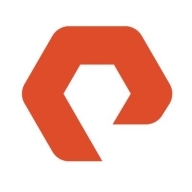


Red Hat Ceph Storage and MinIO compete in object storage solutions. Red Hat Ceph Storage has the upper hand in enterprise-level integration, while MinIO excels in performance for cloud-native environments.
Features: Red Hat Ceph Storage offers seamless integration with Red Hat's ecosystem, scalability, and robust data solutions. MinIO is noted for high performance, simple deployment, and compatibility with AWS S3, making it ideal for cloud-native use.
Room for Improvement: Red Hat Ceph Storage could improve in ease of management and the user interface. It might also benefit from enhanced object storage capabilities. MinIO could enhance its customer support services and increase enterprise-level customization. Improvements in handling large clusters would also be beneficial.
Ease of Deployment and Customer Service: Red Hat Ceph Storage provides a comprehensive deployment process with extensive enterprise support resources. MinIO is known for its ease of deployment in containerized environments, though support relies heavily on community resources.
Pricing and ROI: Red Hat Ceph Storage involves higher initial costs due to its enterprise focus but offers significant ROI through integration and support. MinIO provides a cost-effective setup with impressive ROI for specific use cases, though additional costs might arise for extensive support and customization.
| Product | Market Share (%) |
|---|---|
| Red Hat Ceph Storage | 16.7% |
| MinIO | 17.4% |
| Pure Storage FlashBlade | 5.6% |
| Other | 60.300000000000004% |



| Company Size | Count |
|---|---|
| Small Business | 11 |
| Midsize Enterprise | 11 |
| Large Enterprise | 21 |
| Company Size | Count |
|---|---|
| Small Business | 11 |
| Midsize Enterprise | 4 |
| Large Enterprise | 9 |
| Company Size | Count |
|---|---|
| Small Business | 13 |
| Midsize Enterprise | 4 |
| Large Enterprise | 15 |
FlashBlade is the industry’s most advanced scale-out storage for unstructured data, powered by a modern, massively parallel architecture to consolidate complex data silos (like backup appliances and data lakes) and accelerate tomorrow’s discoveries and insights.
MinIO is an open-source object storage system. It is designed to efficiently store and retrieve unstructured data, such as photos, videos, and backups. MinIO can be used as a standalone object storage server or as part of a larger system, such as a data lake or a private cloud, and can be deployed on-premise, in the cloud, or in a hybrid environment, making it a flexible storage solution for a variety of use cases.
MinIO’s features include erasure coding, bitrot protection, and checksum validation, which help ensure data integrity and reliability. The solution’s multi-tenancy support makes it ideal for multi-user environments. MinIO’s edge computing tools enable data storage and processing closer to users' locations, reducing latency and improving performance. MinIO can easily scale to accommodate storage and power demands, making it ideal for use in large-scale, data-intensive environments.
MinIO Benefits and Features:
MinIO offers several key benefits and features for organizations looking for a scalable and high-performing object storage solution:
Reviews from Real Users
MinIO stands out among its competitors for a number of reasons. Several major ones are its flexibility, integration options, and performance.
Süleyman Fazıl Y., a senior software engineer at a tech services company, writes, “The most valuable features are that MinIO is open, it works on-premise, and is compatible with the Amazon industry which is great for finding compatible libraries in many languages which is very good for developers.”
Rebecca S., CTO at NIASE, says, “MinIO is much improved over the prior solution, updates are simple to apply, and we anticipate that future capacity requirements will be easier to meet. Our customers are using this solution to retrieve tens of thousands of objects (documents and files) per hour, and MinIO seems to be able to keep up with it.”
We monitor all File and Object Storage reviews to prevent fraudulent reviews and keep review quality high. We do not post reviews by company employees or direct competitors. We validate each review for authenticity via cross-reference with LinkedIn, and personal follow-up with the reviewer when necessary.